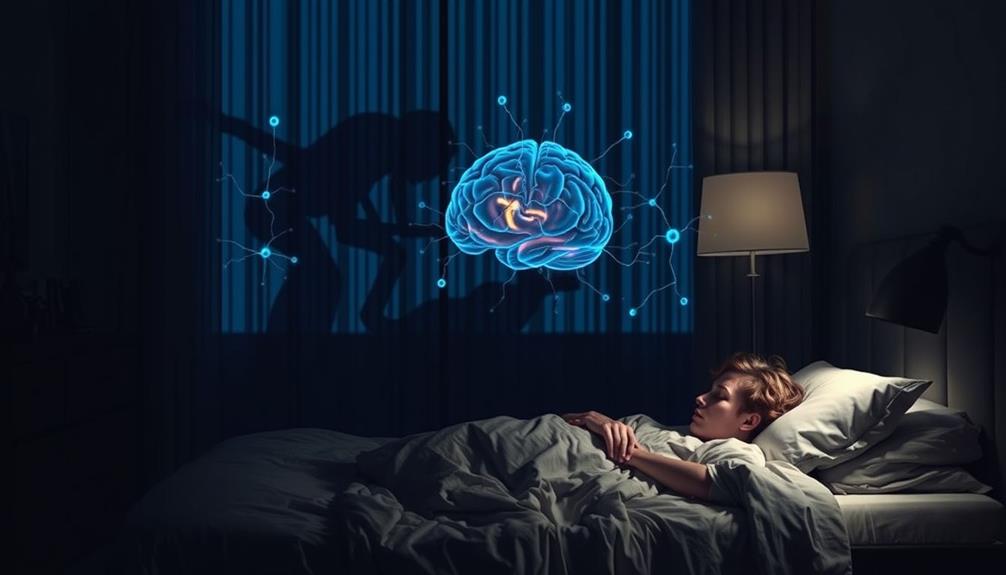The link between Parkinson’s disease (PD) and REM Sleep Behavior Disorder (RBD) is significant and worrisome. If you or someone you know is dealing with RBD, it could signal a higher risk of developing Parkinsonian symptoms in the future. Research indicates that 40-66% of individuals with idiopathic RBD may start experiencing PD symptoms within 10-20 years. RBD is characterized by dream enactment behaviors, a phenomenon more commonly seen in individuals with PD. Recognizing this correlation can aid in early detection and intervention, potentially postponing the onset of motor symptoms. There is still much more to learn about this intricate relationship.
Key Takeaways
- RBD occurs in 20-72% of Parkinson's Disease patients, indicating a significant connection between the two conditions.
- Many individuals with idiopathic RBD develop parkinsonian symptoms within 10-20 years, suggesting a predictive relationship.
- Autopsy studies show that 98% of RBD patients exhibit Lewy body pathology, common in Parkinson's Disease.
- RBD is associated with cognitive decline and higher psychiatric symptoms in PD patients, impacting their overall quality of life.
- Early detection of RBD in PD patients can lead to timely interventions, potentially delaying the onset of motor symptoms.
Overview of Parkinson's Disease

Parkinson's Disease (PD) is a complex neurodegenerative disorder that primarily affects movement. It's characterized by the destruction of dopaminergic neurons in the brain, leading to significant motor and non-motor symptoms. As you age, particularly after 65, the prevalence of PD increases, affecting approximately 0.4% of individuals. The exact cause of Parkinson’s Disease remains unclear, but a combination of genetic and environmental factors is thought to play a role. Advances in research and firsthand experiences, often referred to as living with Parkinson’s insights, have shed light on coping strategies and management approaches that improve quality of life. Early diagnosis and personalized treatment plans are crucial in addressing both the progression of symptoms and the emotional challenges faced by those with PD.
Symptoms include bradykinesia, rigidity, postural instability, and a resting tremor, but don't overlook the non-motor symptoms like olfactory loss and mood disorders. Understanding how to manage your finances is also essential, as budgeting for healthcare expenses can become increasingly important for those affected.
The pathogenesis of PD is closely linked to dopamine deficiency, which occurs after about 80% of dopaminergic neurons in the basal ganglia and substantia nigra are lost. Understanding these changes is imperative, as PD progresses through six stages, beginning with presymptomatic phases where symptoms may not yet be evident.
Early recognition of non-motor symptoms, especially sleep disturbances, is crucial for timely diagnosis and management. Cognitive impairment can also arise as the disease advances, complicating patient care.
Understanding REM Sleep Behavior Disorder

Sleep disturbances are common among those with Parkinson's Disease, and one significant condition linked to it is REM Sleep Behavior Disorder (RBD). RBD is characterized by the loss of muscle atonia during REM sleep, causing you to act out your dreams. This can lead to injuries for both you and your bed partner. The prevalence of RBD is about 4.9% in the general population, but it skyrockets to between 20-72% in individuals with Parkinson's Disease. RBD is just one of several sleep disorders in Parkinson’s that can significantly impact quality of life. Other common issues include insomnia, restless legs syndrome, and excessive daytime sleepiness, all of which can exacerbate the motor and cognitive symptoms of the disease. Treating sleep disorders in Parkinson’s often requires a multidisciplinary approach involving medications, behavioral therapies, and sleep hygiene strategies.
RBD often serves as a prodromal marker for PD, with approximately 40-66% of those with idiopathic RBD developing parkinsonian symptoms within 10-20 years. Diagnosis typically involves a sleep study to confirm abnormal muscle activity.
Here's a quick look at some key aspects of RBD:
| Aspect | Details | Treatment Options |
|---|---|---|
| Symptoms | Acting out dreams, potential for injury | Melatonin (OTC) |
| Prevalence | 4.9% general; 20-72% PD | Clonazepam (may affect cognitive performance) |
| Prodromal Marker | 40-66% develop PD symptoms | |
| Diagnosis | Clinical history, polysomnography | |
| Neurodegenerative Disorders | Associated with PD and other disorders |
Understanding RBD is vital for managing sleep disturbances effectively.
Relationship Between PD and RBD

A significant connection exists between REM Sleep Behavior Disorder (RBD) and Parkinson's Disease (PD), revealing crucial insights into the progression of neurodegenerative conditions. RBD is characterized by dream enactment, where individuals physically act out their dreams, and it's often seen in PD patients.
Studies show that approximately 40-66% of those with idiopathic RBD (iRBD) may develop parkinsonian syndrome within 10 to 20 years, emphasizing the strong association between these conditions. Furthermore, the growing demand for professionals in fields related to healthcare, such as AI cybersecurity jobs, highlights the importance of safeguarding medical data and research related to neurodegenerative diseases.
Autopsy findings further solidify this link, with 98% of polysomnography-confirmed RBD patients displaying Lewy body pathology, a hallmark of PD. Importantly, RBD is more prevalent in the akinetic/rigid-dominant subtype of PD, indicating its role in the clinical manifestations of the disease.
Additionally, the presence of RBD correlates with increased cognitive decline and mood disorders in PD patients, raising concerns about a higher likelihood of developing dementia. This connection suggests that RBD could serve as an early indicator of neurodegenerative processes, highlighting the importance of recognizing sleep disorders in the context of Parkinson's Disease to facilitate timely intervention and management.
Cognitive and Psychiatric Impacts

In individuals with Parkinson's Disease (PD) who also experience REM Sleep Behavior Disorder (RBD), significant cognitive deficits often emerge, impacting various areas such as executive functioning, memory, and visuospatial skills.
You may notice that those with PD and RBD perform worse than both PD patients without RBD and healthy controls. This cognitive impairment often correlates with increased psychiatric symptoms, including higher levels of depression and anxiety.
The interplay between cognitive and emotional development can be complex, as key domains of development influence overall well-being. Approximately 40-66% of individuals with idiopathic RBD may develop parkinsonian syndrome within 10-20 years, which suggests a clear link between RBD and cognitive decline in PD.
The presence of RBD is associated with a higher prevalence of mild cognitive impairment (MCI) and could serve as a risk factor for dementia. It's essential to recognize that psychiatric symptoms, such as apathy, can exacerbate cognitive challenges, complicating your assessment of overall cognitive functioning.
Understanding these cognitive and psychiatric impacts is critical for managing the complexities of PD and RBD.
Early Detection and Interventions

How can early detection of REM Sleep Behavior Disorder (RBD) markedly influence the management of Parkinson's Disease (PD)? Identifying RBD early can serve as a pivotal indicator of potential neurodegeneration, given that 20-72% of PD patients present with this disorder.
By using validated screening tools like the Mayo Sleep Questionnaire, you can help pinpoint individuals at risk, allowing for timely interventions that may delay the onset of motor symptoms.
Cold medications overview suggests that timely management of related symptoms can play an essential role in overall health. Research shows that 40-66% of idiopathic RBD patients may develop parkinsonian syndrome within 10-20 years.
Implementing effective management strategies, such as medications like melatonin and clonazepam, can greatly improve sleep quality, which in turn may reduce associated cognitive decline in PD patients.
As a clinician, it's important to recognize the strong link between RBD and cognitive deficits, advocating for thorough assessments that include evaluations of sleep patterns.
Frequently Asked Questions
How Is REM Sleep Disorder Connected to Parkinson's Disease?
REM sleep disorder involves dream enactment and muscle activity during sleep. If you experience these symptoms, it might indicate a potential neurodegenerative condition, as many patients eventually develop Parkinson's Disease over time.
What Triggers REM Sleep Behavior Disorder?
You might think sleep is all about peace and quiet, but REM Sleep Behavior Disorder triggers from losing muscle atonia. This allows you to act out dreams, often leading to unexpected movements and noises.
What Sleep Disorder Is Precursor to Parkinson's Disease?
If you're curious about sleep disorders that may precede Parkinson's disease, REM Sleep Behavior Disorder (RBD) is a significant one. Understanding its symptoms can help you recognize early signs of potential neurodegenerative issues.
What Is the Life Expectancy of Someone With Rbd?
If you have REM Sleep Behavior Disorder, your life expectancy can vary considerably. While some manage well, studies suggest that many may face additional health challenges, potentially impacting longevity, so it's crucial to monitor your health closely.
Conclusion
In summary, the link between Parkinson's disease and REM sleep behavior disorder can't be overlooked. Research suggests that RBD often precedes PD, potentially serving as an early warning sign. By recognizing this connection, you can advocate for early interventions that might delay or mitigate the onset of Parkinson's symptoms. As theories around neurodegeneration evolve, your awareness of these disorders could play an essential role in enhancing both your understanding and your health management strategies.









